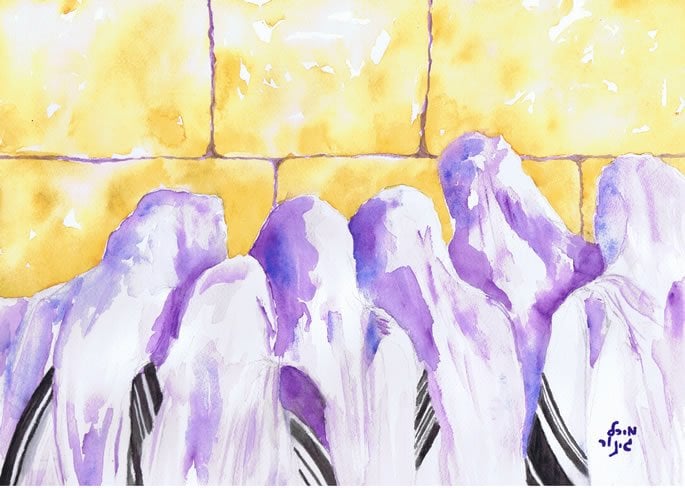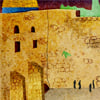The Western Wall is the only surviving structure of the Temple Mount still standing since the Temple era. Perhaps the most famous Jewish destination in Israel and beyond, millions from across the globe travel to this sacred site to pray and find inspiration. Read on for 12 facts about this ancient Temple remnant.
1. It Was Part of the Temple Mount
It is commonly thought that the Western Wall was part of the Holy Temple. However, according to the accepted view, the Western Wall was a segment (not of the actual Temple but) of the retaining wall surrounding the Temple Mount.1 This wall was built by Herod the Great in the 1st century BCE when he ambitiously expanded the Temple Mount and renovated the Second Temple.2
Read: The Western Wall
2. It Was Spared Destruction by the Romans
When the Holy Temple was destroyed by the Romans in 70 CE, the Western Wall miraculously remained standing. According to the Midrash, the general assigned with tearing down the Western Wall chose to keep it, intending to showcase to future generations the greatness of the structure they had razed.3 Of course, the real reason it survived is because G‑d desired that a remnant of the Temple remain intact—a holy place for Jewish people to gather and pray.
3. It Survived Due to a Divine Promise

We read in Song of Songs, “Behold, He is standing behind our wall, looking from the windows, peering from the lattices.”4 The Midrash explains that the wall refers to the Western Wall. “Why is this so? Because the Holy One, Blessed be He, has taken an oath that it will never be destroyed.”5 Based on that, the Zohar states: “The Divine Presence never departed from the Western Wall.”6
4. The Upper Layers Were Added Centuries Later
Of the visible part of the wall, only the bottom seven rows, consisting of large stones with indented borders, are from Herod's project. The next section, four layers of smaller, plainer stones, dates back to the Byzantine period. The following layer was added sometime after the Muslim conquest in the 7th century, and the topmost layer was added in the 19th century, paid for by the famed British philanthropist and financier, Sir Moses Montefiore.
Read: Sir Moses Montefiore
5. No Jews Could Visit for Almost Two Decades
In 1948, Jordanian troops occupied the Old City of Jerusalem and Jews were altogether banned from visiting the Wall. The holy site remained inaccessible to Jews for 19 years, until Israeli paratroopers liberated the Temple Mount during the Six-Day War.
Read: 15 Facts About Jerusalem
6. Its Liberation Evoked Unparalleled Emotion
On June 7, 1967, the third day of the Six-Day War, an Israeli brigade led by commander Mordechai Gur secured control of Jerusalem’s Old City. As they approached the Wall, their eyes brimmed with tears as they gazed at the sacred stones. This scene repeated itself numerous times as Jews from all walks of life visited the Wall in great numbers over the coming months, all basking in the site’s palpable spiritual aura.
7. The Plaza Used to Be Much Smaller

Before the Six-Day War, the accessible portion of the Wall was limited to a 100-foot stretch of the massive wall, extending only 10 feet wide. After reclaiming the Temple Mount, the entire area before the Wall was leveled and paved, creating a large open plaza with room for thousands of visitors.
8. Much of It Is Hidden Underground
Even today, much of the wall remains hidden from view. The northern portion of the Wall is blocked by buildings in the adjacent Muslim Quarter, and 17 layers of stone are buried beneath the ground. If you want to access this hidden treasure, tours are available in which the entire length of the Wall can be traversed underground. A key highlight of this tour is the subterranean synagogue situated at the point directly opposite where the Holy of Holies once stood.
9. It Is Also Known as the Kotel and the Wailing Wall
The Western Wall is also known as the Kotel, Hebrew for wall. Another name for the wall is the Wailing Wall. The reason for this name is that during the Christian rule of Jerusalem in the Byzantine period (324–638 CE), Jews were barred from entering Jerusalem, except for one day a year, on the 9th of the Jewish month of Av, the day that the Holy Temple was destroyed. On that day, the Christian rulers would let the Jews visit the Temple Mount, where they would cry and mourn the destruction of the Holy Temple. Due to this, the Christians started referring to the Western Wall as the Wailing Wall.7
10. Its Crevices Are Filled With Handwritten Notes

Upon closer inspection of the Wall, one can observe countless slips of paper placed between its cracks. These notes contain requests written to G‑d, inserted by many of the petitioners visiting the site. Although some have questioned this tradition, citing concerns about our current state of ritual impurity,8 it remains widely accepted to insert these notes into the Kotel as a means of seeking Divine intervention.9
11. It Is Home to Unique Fauna and Flora
In addition to millions of human visitors, the Wall provides habitat to various members of the plant and animal kingdoms. Several plants grow from between the rocks, including the ephedra, golden henbane, horsetail knotgrass, and thorny caper. Swifts, swallows, and doves nest in the crevices, and geckos peek surreptitiously from between the ancient stones.
12. It Hosts the Busiest Chabad House in the World

The Chabad-run tefillin booth at the Kotel is arguably the busiest Chabad House in the world, attracting hundreds of visitors every day. Manned by several rabbis fluent in multiple languages, the stand is open from morning until dusk and provides, in addition to tefillin-laying opportunities, Jewish literature, information about upcoming Jewish holidays, and a listening ear to anyone in need.








Join the Discussion